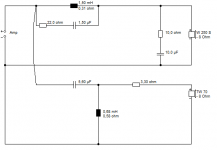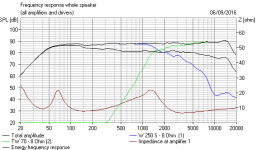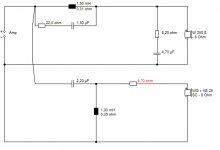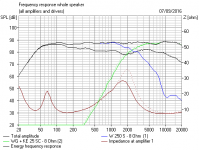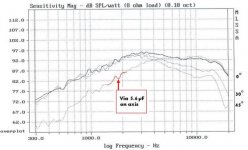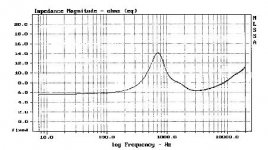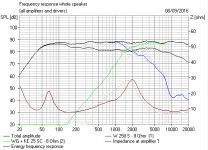I think it's a fun idea to try.
I was reading about the Zu Druid V speaker, based on a modified Eminence B102 and a ASD 1001 compression driver.
6moons audioreviews: Zu Druid V
It's obviously a very revealing driver with low mechanical loss. Some dispersion issues, I'd guess, but what have you got to lose? FWIW, 3khz notch often works well with 10".
I was reading about the Zu Druid V speaker, based on a modified Eminence B102 and a ASD 1001 compression driver.
6moons audioreviews: Zu Druid V
It's obviously a very revealing driver with low mechanical loss. Some dispersion issues, I'd guess, but what have you got to lose? FWIW, 3khz notch often works well with 10".
Great, thanks.
Seems like a rugged woof too.
I've thought a high qms is more revealing than a low one, less mechanical resistance to motion.
Cool.
Seeing the graph, if the z is 30 ohms @ 3khz, how much ohmage on notch ?
Norman
Seems like a rugged woof too.
I've thought a high qms is more revealing than a low one, less mechanical resistance to motion.
Cool.
Seeing the graph, if the z is 30 ohms @ 3khz, how much ohmage on notch ?
Norman
I don't subscribe to the ohmage theory. All you need to know is that this is a low inductance woofer around 0.6mH like most eminence speakers.
So if you have a bass coil 2X or 3X bigger, its going to be flat enough. Eminence often recommend 2mH and 10uF shunt on the bass, with 3.3uF and 0.3mH on the tweet.
Let's look at the FR:
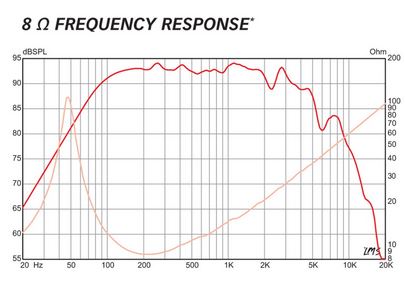
I think you'll end up around 2.5kHz crossover. Below is some modelling of mine with a far less efficient high inductance 10" woofer and a cone tweeter. It all seems to play nicely enough. Second order at least on the tweeter though. Hope it helps. It's your project.
So if you have a bass coil 2X or 3X bigger, its going to be flat enough. Eminence often recommend 2mH and 10uF shunt on the bass, with 3.3uF and 0.3mH on the tweet.
Let's look at the FR:

I think you'll end up around 2.5kHz crossover. Below is some modelling of mine with a far less efficient high inductance 10" woofer and a cone tweeter. It all seems to play nicely enough. Second order at least on the tweeter though. Hope it helps. It's your project.
Attachments
ty.
Yea, the morel may melt, but it is a rugged tweet and I'm not trying to impress anyone with how loud my system is anymore.
So you mean just put a coil on the b102 maybe 1.2-1.8mH and forget ?
A 12db would get me away from a time aligned (and phase aligned) setup.
and the b102 (once notched peak out) seems 6db down at 4khz, maybe 12db down at 8khz, almost a 6db rolloff.
Still on the fence but definitely getting wobbly....................
Yea, the morel may melt, but it is a rugged tweet and I'm not trying to impress anyone with how loud my system is anymore.
So you mean just put a coil on the b102 maybe 1.2-1.8mH and forget ?
A 12db would get me away from a time aligned (and phase aligned) setup.
and the b102 (once notched peak out) seems 6db down at 4khz, maybe 12db down at 8khz, almost a 6db rolloff.
Still on the fence but definitely getting wobbly....................
I think you should forget preconceived notions about 12dB/octave or 6dB/octave and time-alignment. You get what you get with various drivers, and go with the flow.
I think I'm working harder at this than you. Here's some homework:
DeVore Fidelity Orangutan O/96 loudspeaker Measurements | Stereophile.com
TQWT-
Designing Loudspeakers - WD25T EX - The next step
Looks like you are just going to scrape it on tweeter level here. I decided that 2.5kHz XO was a good place to be. The bass filter, mere shaping really, is almost written in stone.
Phase alignment isn't very critical. Just seems to work. Most of your efforts will be adjusting the tweeter filter. I'd guess 4.7uF will be reasonable as a simple cap filter here. That 14ohm Fs lump on the ferrofluid CAT 378 shouldn't be too problematic, but I don't like that sort of thing much from listening experience.
A couple of second-order filters seem to play nicely, but values are affected by how much attenuation you need, in fact they all end up in much the same place. The dotted line is what I called the Devore 1 filter.
Nobody gets a speaker right first time. Not even Troels. Because there are trade-offs. But the sort of project I would take on. The final tweeter crossover is not going to be more than 3 components, which can't be that hard. 🙂
I think I'm working harder at this than you. Here's some homework:
DeVore Fidelity Orangutan O/96 loudspeaker Measurements | Stereophile.com
TQWT-
Designing Loudspeakers - WD25T EX - The next step
Looks like you are just going to scrape it on tweeter level here. I decided that 2.5kHz XO was a good place to be. The bass filter, mere shaping really, is almost written in stone.
Phase alignment isn't very critical. Just seems to work. Most of your efforts will be adjusting the tweeter filter. I'd guess 4.7uF will be reasonable as a simple cap filter here. That 14ohm Fs lump on the ferrofluid CAT 378 shouldn't be too problematic, but I don't like that sort of thing much from listening experience.
A couple of second-order filters seem to play nicely, but values are affected by how much attenuation you need, in fact they all end up in much the same place. The dotted line is what I called the Devore 1 filter.
Nobody gets a speaker right first time. Not even Troels. Because there are trade-offs. But the sort of project I would take on. The final tweeter crossover is not going to be more than 3 components, which can't be that hard. 🙂
Attachments
Seems like Mr. Bates is seeking a design somewhat similar to some of the vintage New England speakers like EPI or Advent (more complex XO's). Most of those crossed in the 1K to 2K region. Have you considered a high end cone tweeter? One of System 7's favorite speakers utilizes one. I don't recall the brand. sorry. It looks like the speaker on the left in Post #2.
I doubt if Norman Bates is his real name, wasn't he the creepy guy in "Psycho"? 😀
I've been simming something similar with a genuine waveguide tweeter, albeit a sophisticated one with a an Fs notch built in. It gets nowhere near 6dB/octave, of course.
You could take the crossover lower, of course, and dispersion improves. It looks like this first-order. With the likely less attenuation with the B102 woofer, the cap would probably be near enough 4.7uF with no resistors. But actually 5.6uF and 15R shunt would be better IMO to damp the Fs a bit.
You can see the tweeter is being worked much harder at low frequency. So distorts more, which is the trade-off. Phase is a bit off, but happily lobes above axis, which is where most of us listen. In fact a bit BW3, which is no bad thing.
I think the bass coil and related notch might be a bit select on test. I really couldn't guess what will sound balanced here, but you can usually just listen to the woofer on its own and get it right.
I've been simming something similar with a genuine waveguide tweeter, albeit a sophisticated one with a an Fs notch built in. It gets nowhere near 6dB/octave, of course.
You could take the crossover lower, of course, and dispersion improves. It looks like this first-order. With the likely less attenuation with the B102 woofer, the cap would probably be near enough 4.7uF with no resistors. But actually 5.6uF and 15R shunt would be better IMO to damp the Fs a bit.
You can see the tweeter is being worked much harder at low frequency. So distorts more, which is the trade-off. Phase is a bit off, but happily lobes above axis, which is where most of us listen. In fact a bit BW3, which is no bad thing.
I think the bass coil and related notch might be a bit select on test. I really couldn't guess what will sound balanced here, but you can usually just listen to the woofer on its own and get it right.
Attachments
here's one cabinet for B102 - wonder where its tuned? you can plop an APT50 on it when wanting a different sound than 378 (what existing object might substitute for that "reflector"?) fwiw, I can't find dimensions for the "Jetline 100" port. That line seemed to have a positive diameter taper. An impedance graph would sure help.
I might move my lone "new spec" B102 from a tiny Karlson to a junk 70 liter reflex tuned ~41Hz - wish I had a CAT378 but they ain't free

I might move my lone "new spec" B102 from a tiny Karlson to a junk 70 liter reflex tuned ~41Hz - wish I had a CAT378 but they ain't free

Last edited:
eek, can't imagine b102 sounds good past 2khz.
Others probably would not even it push it up that high.
I'm pretty sure tekton uses a 12db on their Lore (10" + gold audax).
http://techtalk.parts-express.com/forum/tech-talk-forum/63949-gut-shots-of-a-tekton-lore
do you have a link so I can use translator on that K+T project ?
Yea, I'm not one for pipe ported things but I see it is useful for getting it near ear level.
Getting closer, waiting for a buddy to hop on so I can get free shipping for the tweet and cap.
norman
Others probably would not even it push it up that high.
I'm pretty sure tekton uses a 12db on their Lore (10" + gold audax).
http://techtalk.parts-express.com/forum/tech-talk-forum/63949-gut-shots-of-a-tekton-lore
do you have a link so I can use translator on that K+T project ?
Yea, I'm not one for pipe ported things but I see it is useful for getting it near ear level.
Getting closer, waiting for a buddy to hop on so I can get free shipping for the tweet and cap.
norman
- Principle: bass reflex speaker with Rundumstrahler
(Yet? Hifi) a guitar speaker for hifi - to use box is very unusual, and since the beginning of the story already unusually started the guitar speaker has been complemented by an unusual tweeter: a horn driver without a horn, which is a diffuser cone is placed opposite, so that the tweeter radiates all around.
This combination is certainly not able to play tonally balanced classical pieces, but for lovers of horns it is certainly an interesting alternative.
The crossover used only corrects the high-frequency driver and separating it off with a 12 dB / octave high pass below 5 kHz. This is necessary because the tweeter would be overloaded with deep shades otherwise.
An excerpt from the Klang + Ton
.. "The tangy, but not intrusive by the good energy distribution tweeter blends almost frighteningly well with the directly radiated bass-midrange. The works extremely energy-rich and energetic directly and makes its origin unmistakably clear. He transported the most power in the bass and lower midrange, .. making higher volumes easily drinkable and it is a terrific bass, the production of the B102 depth, full and very round, almost as a transmission Line Clear, this chassis was indeed built for this frequency range What is -.. at least directly on axis - connecting it will drive small boxes-loving neutrality fanatics immediately out of the room, while the broadband fan shoots water into the eyes may not slag free to perfection, but with an enormous serving Schmackes fires the B102 its sound in the room.. who's then something gentle preferably the box rotates easily from the center and enjoying a smoother, more indirect sound. Of course at the great space and the HF driver has a large share, almost imperceptibly participates in the event. Clearly its share is at this speaker when pinches him tentatively times. Then once the lights go out, and the box bags spatially together. With treble it acts openly and freely, without the latter would require emphasis. Nevertheless, one notices at high levels that here hinspielt no soft cap on. Even without the horn can APT50 vigorously tackling issues and to provide a pool forcefully into the room. To give the unit both chassis an experience of a different kind, which is certainly not only once forgets. AC / DC on the platter, level up, rock'n'roll! "
I once fired an APT50 variant up into a styrofoam coffee cup with a parabolic slot I cut into the side of the cup with scissors - that make a nice helper tweeter for my 12kta
(Yet? Hifi) a guitar speaker for hifi - to use box is very unusual, and since the beginning of the story already unusually started the guitar speaker has been complemented by an unusual tweeter: a horn driver without a horn, which is a diffuser cone is placed opposite, so that the tweeter radiates all around.
This combination is certainly not able to play tonally balanced classical pieces, but for lovers of horns it is certainly an interesting alternative.
The crossover used only corrects the high-frequency driver and separating it off with a 12 dB / octave high pass below 5 kHz. This is necessary because the tweeter would be overloaded with deep shades otherwise.
An excerpt from the Klang + Ton
.. "The tangy, but not intrusive by the good energy distribution tweeter blends almost frighteningly well with the directly radiated bass-midrange. The works extremely energy-rich and energetic directly and makes its origin unmistakably clear. He transported the most power in the bass and lower midrange, .. making higher volumes easily drinkable and it is a terrific bass, the production of the B102 depth, full and very round, almost as a transmission Line Clear, this chassis was indeed built for this frequency range What is -.. at least directly on axis - connecting it will drive small boxes-loving neutrality fanatics immediately out of the room, while the broadband fan shoots water into the eyes may not slag free to perfection, but with an enormous serving Schmackes fires the B102 its sound in the room.. who's then something gentle preferably the box rotates easily from the center and enjoying a smoother, more indirect sound. Of course at the great space and the HF driver has a large share, almost imperceptibly participates in the event. Clearly its share is at this speaker when pinches him tentatively times. Then once the lights go out, and the box bags spatially together. With treble it acts openly and freely, without the latter would require emphasis. Nevertheless, one notices at high levels that here hinspielt no soft cap on. Even without the horn can APT50 vigorously tackling issues and to provide a pool forcefully into the room. To give the unit both chassis an experience of a different kind, which is certainly not only once forgets. AC / DC on the platter, level up, rock'n'roll! "
I once fired an APT50 variant up into a styrofoam coffee cup with a parabolic slot I cut into the side of the cup with scissors - that make a nice helper tweeter for my 12kta
Last edited:
I like that overview - its more honest sounding than a lot of "reviews" and even in machine translation, conveys a means to understand the balance, strengths, and weaknesses of the speaker and how it might sound. It does seem like a pretty good little rocker and would be easy to adapt to Cat378.
would a little Faital with B102 make a usable "FAST" ?
- wonder why Klang + Ton has not done a "Karlson"? - the original little K12 with 12" and 80-95 ounce magnet and compression driver on K-tube has huge dynamics - within its limited LF reach
would a little Faital with B102 make a usable "FAST" ?
- wonder why Klang + Ton has not done a "Karlson"? - the original little K12 with 12" and 80-95 ounce magnet and compression driver on K-tube has huge dynamics - within its limited LF reach
Thanks for the translate.
I'm not keen on the pipe responses maybe due to squarish box (jagged response under 1khz), like the druid box you've built.
The morel is easy to roll in due to same sensitivity. A compression driver has higher inductance and will resonate with a cap. The klipsch rf7 had the same problem I think. But you can use cap / resistor to get level right. Ideally the morel would be more revealing if it didn'the have ferrofluid.
I'm not keen on the pipe responses maybe due to squarish box (jagged response under 1khz), like the druid box you've built.
The morel is easy to roll in due to same sensitivity. A compression driver has higher inductance and will resonate with a cap. The klipsch rf7 had the same problem I think. But you can use cap / resistor to get level right. Ideally the morel would be more revealing if it didn'the have ferrofluid.
I've built two ways with the SEAS 10" shown (H1411-8). While it does have a gentle roll off, if there is substantial program material just above the tweeter crossover point - let's say around 2khz - there is a pronounced 'shouting' effect from the woofer.
Troels puts this down to beaming modes, his primary reason to develop his excellent 8" driver.
In practice, lowering the crossover point with more filtering and a waveguide for the tweeter yielded better balance in this range.
I modified a 10" waveguide from PE, with a 27TFFC crossed at 1.5k to the H1411-8. Substitute an Eminence Deltalite 2512 for better impulse response (same crossover point)
Sent from my Nexus 6 using Tapatalk
Troels puts this down to beaming modes, his primary reason to develop his excellent 8" driver.
In practice, lowering the crossover point with more filtering and a waveguide for the tweeter yielded better balance in this range.
I modified a 10" waveguide from PE, with a 27TFFC crossed at 1.5k to the H1411-8. Substitute an Eminence Deltalite 2512 for better impulse response (same crossover point)
Sent from my Nexus 6 using Tapatalk
Got b102 in a box today.
No tweet hooked up but good start.
I forgot how much a woof mid is important.
Interesting how we forget how much info runs up to 2khz.
Prebuilt box, 1.4ft3 tuned to 42hz.
Mdf plywood ?
Strangest wood I've ever seen, but done, mounted, and hooked up under tv already.
Tonight i'll solder cap to tweet and get wires run.
Cat378, not sure but will figure out how to hold it in place tonight.
No tweet hooked up but good start.
I forgot how much a woof mid is important.
Interesting how we forget how much info runs up to 2khz.
Prebuilt box, 1.4ft3 tuned to 42hz.
Mdf plywood ?
Strangest wood I've ever seen, but done, mounted, and hooked up under tv already.
Tonight i'll solder cap to tweet and get wires run.
Cat378, not sure but will figure out how to hold it in place tonight.
sounds like a good sturdy box - is is something like "Pro-Core2" ?
https://hw.menardc.com/main/bargainitem/600162/large/a4116c995456ebb11489201200.png
https://hw.menardc.com/main/bargainitem/600162/large/a4116c995456ebb11489201200.png
seems so, double thick front wall, super heavy with b102 in it.
I'll add some fill this weekend.
Worst case scenario, it can be part of a 3-way, but I'm sure this will be an excellent project for me.
I'll add some fill this weekend.
Worst case scenario, it can be part of a 3-way, but I'm sure this will be an excellent project for me.
you could temporarily make a little baffle for for CAT378, use wood or L-bracket supports so it could be scooted into alignment.
is the cab a "Q-bomb 10"? - how long is the port? side exit ?
is the cab a "Q-bomb 10"? - how long is the port? side exit ?
I've no clue what it is.
prebuilt.
port slot is almost as deep as the box.
Got cap soldered on and wires.
Ready for hookup later tonight.
It can sit on some grip rubber and foam, it won't roll.
prebuilt.
port slot is almost as deep as the box.
Got cap soldered on and wires.
Ready for hookup later tonight.
It can sit on some grip rubber and foam, it won't roll.
what do you think ? here's the cabinet I spoke of https://i5.walmartimages.com/asr/68....jpeg?odnWidth=843&odnHeight=843&odnBg=ffffff
- Home
- Loudspeakers
- Multi-Way
- 10" woof plus single capped Morel CAT378
